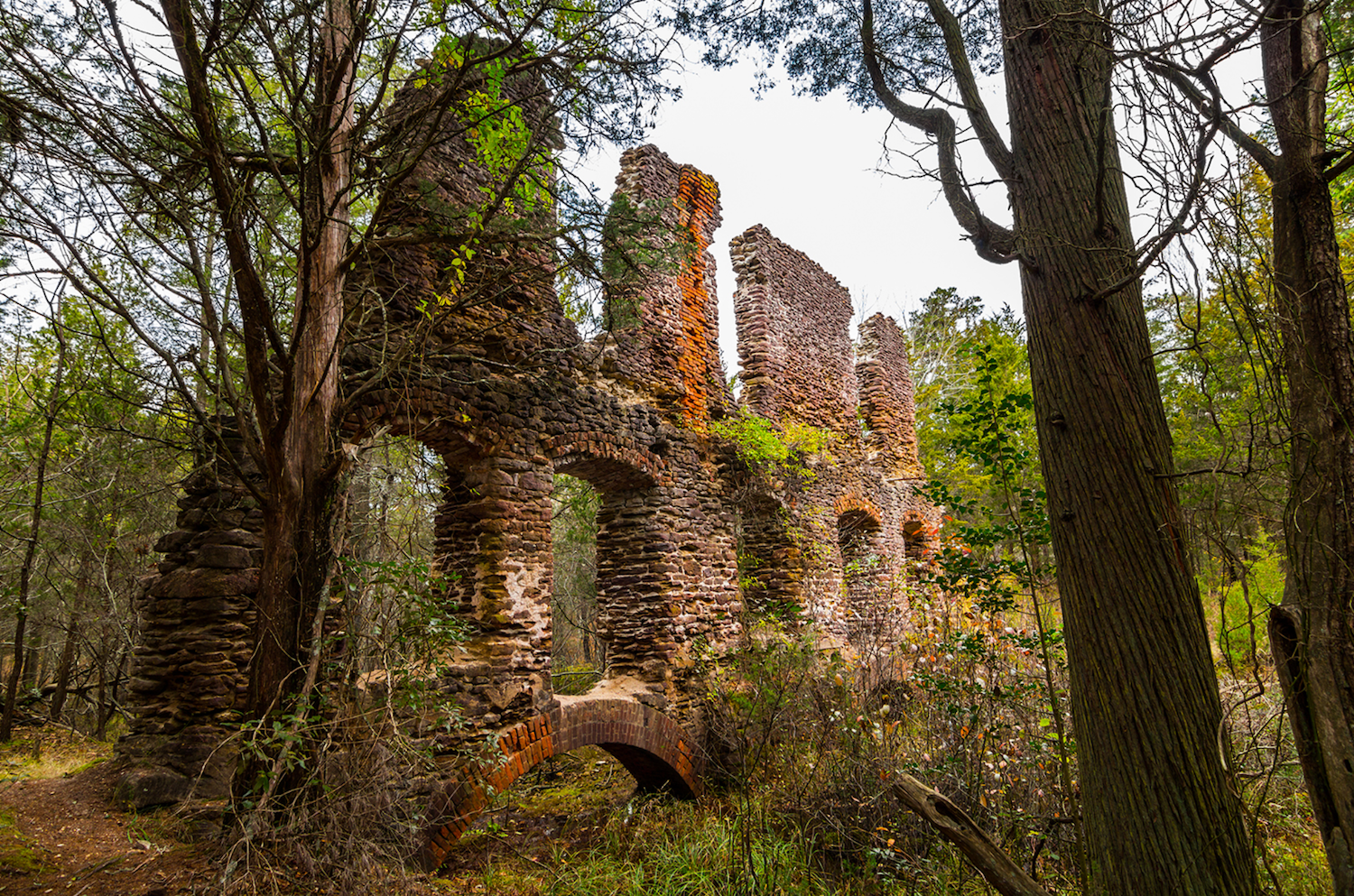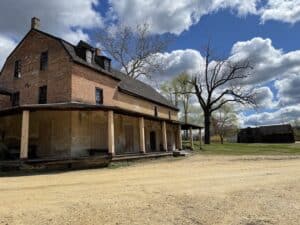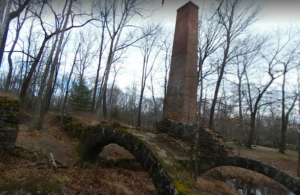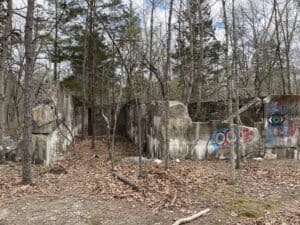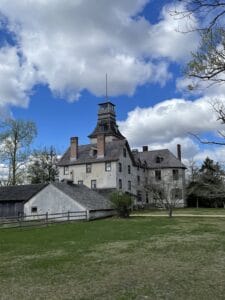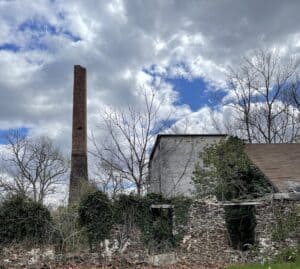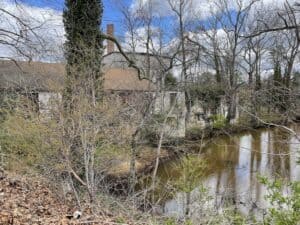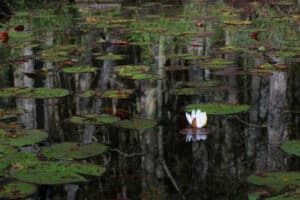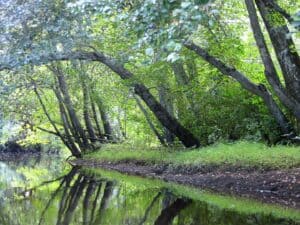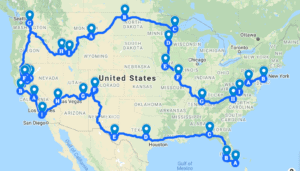When I first learned of the ghost towns of New Jersey, I could hardly believe it. How could a state with more than 1,200 people per square mile have ghost towns in it? In New Jersey there are people everywhere. And the traffic? Hell, you can’t even make a left turn at a green light because the concentration and speed of oncoming traffic is so intense. Where would these ghost towns be? Underground?
Nevertheless, I liked the idea. I was intrigued by the notion that there could exist a part of New Jersey that didn’t involve being tailgated on a four lane highway at 75 mph, a place where a cat could cross a road without fear of being obliterated, and a place where birdsong is not drowned out by the noise of air brakes and back up beeps.
Turns out there is such a place, an over the rainbow place called the Pine Barrens.
Ghost Towns of New Jersey
Travel thirty-five miles due east from Philadelphia and you’ll run right into it. The Pine Barrens is not small. It covers 1.1 million acres, twenty-two percent of New Jersey’s total land area. As the name implies it is heavily forested with pines. The soil is sandy. Cedar swamps and peat bogs speckle the landscape. Bears and bobcats roam the woods. Orchids float placidly on the surfaces of ponds. And ghost towns? Yep, there are ghost towns. Plenty of them.
Most are the result of the area’s steep drop-off in population following its peak in the mid-1800’s. A few are the result of earlier generations seeking the seclusion of the Pine Barrens for clandestine activities.
One such is Amatol, a secret army munitions facility where an explosive of the same name was manufactured during World War I. At the time, the plant was surrounded by barracks, homes and office blocks. Today, nothing remains but the graffiti-marred concrete walls of former structures. The site was abandoned after the war ended in 1919.
Seven miles down the road is a ghost town more typical of the Pine Barrens. Weymouth Furnace was an iron producing facility that forged high quality cast iron from 1754 to 1865. At its height it employed 90 people. The forge had four fires and two hammers which could produce two-hundred tons of bar iron per year. Today, it’s a crumbling ruin. Only its chimney and a couple of stone trusses remain.
Batsto Village
By far the most well preserved ghost town in the Pine Barrens is Batsto Village. Founded in 1766 as an iron works near the mouth of the Batsto River, the village prospered for more than a century, converting its facilities to the production of window glass when the iron industry went into decline in the late 19th century. By the early 20th century, Batsto Village was abandoned.
Today, the site is dominated by a striking Italianate mansion that once served as the owners’ home during the village’s high water mark. It overlooks the preserved barns, stables and shops of the village, more than fifteen in all, as well as a gristmill, sawmill and church. To get a sense of what a prosperous Pine Barren village was like in the early 18th century, Batsto Village can’t be beat.
But the question remains, having achieved such prosperity in the 19th century, what happened?
Bog Iron
European settlers first explored the Pine Barrens in the late 1600’s in search of wood for shipbuilding. By the early 1700’s sawmills had cropped up to serve the growing timber trade. But iron was the commodity that drove the region’s boom.
In the colonial era iron was harvested from bogs, and the Pine Barrens had plenty of those. A bog is wet, muddy ground formed by dead plant material called peat. Bogs are too spongy to be built on but they develop iron beneath the surface in small pea-sized nodules that can be harvested and smelted.
The prevalence of bog iron in the Pine Barrens drew iron producers to the region in the mid-1700’s. The first iron furnace opened in 1765. By the early 1800’s there were thirty-five of them, each with a small community of workers around it. In the 18th century the Pine Barrens produced the iron to make the cannons that won the Revolutionary War. To this day much of the wrought iron seen in the city of Philadelphia came from the Pine Barrens. But the boomtimes would not last. Progress was catching up with the Pine Barrens.
Off the Radar
By the mid-1800’s the American population had moved west into the Great Lakes region where good timber for shipbuilding was plentiful and cheap. At the same time, methods for extracting iron ore from rock had advanced, so it became cheaper to mine good quality ore from rich deposits in Pennsylvania and Minnesota. Gradually, the sawmills and furnaces of the Pine Barrens fell silent. The people moved away. The villages were abandoned and became ghost towns. But why did it remain that way for so long?
It’s difficult to wrap your mind around the fact that 1,700 square miles of available land within thirty-five miles of Philadelphia remains mostly undeveloped well into the 21st century. Philadelphia is the fifth most populous city in the United States. If proximity were a factor, it should have been developed into a thriving suburban enclave of a half million people a long time ago. Thirty-five miles is not that far. To put it in context, thirty-five miles is the distance from Los Angeles to Anaheim. Thirty-five miles is the distance from Miami to Ft Lauderdale.
It was the lack of good farmland that kept the Pine Barrens off the radar. The soil is too sandy and acidic for most crops. Today, Pine Barren farmers successfully grow cranberries and blueberries there, but in the late-1800’s when farming was the engine that drove the nation’s economy, staple crops could not be grown there. As a result, people settled elsewhere. And by the time developers began greedily eyeing the area for development, the federal government stepped in to protect it.
400 Gallons per Minute
The wet, sandy soil of the Pine Barrens recharges the massive Kirkwood-Cohansey Aquifer, which contains 17.7 trillion gallons of water. The commercial development of the Pine Barrens would threaten the aquifer, which yields water for public and industrial use to the tune of 400 gallons per minute. In effect, the Pine Barrens is a giant reservoir with a thick layer of land on top of it. To develop it would be to damage the reservoir underneath. Fortunately, the federal government realized this in time to save it.
In 1978, under mounting pressure to build a large regional airport in the area, Congress created the New Jersey Pinelands Natural Reserve to protect the Pine Barrens. Six years later UNESCO designated it a US Biosphere Reserve. Today, the Pine Barrens contains four state forests and two national scenic waterways, ratifying its distinction as a sprawling wilderness the size of the state of Rhode Island in the middle of the most densely populated state in the country. It’s bizarre and incongruous and maybe just a little creepy. The Pine Barrens has long been a place where people have been made to feel uneasy by the juxtaposition of the familiar and the strange. Perhaps that’s why there are so many scary stories and legends attached to it.
The New Jersey Devil and Other Legends of the Swamp
As legend has it, on a stormy night in 1735 Jane Leeds, a mother of twelve, gave birth to her thirteenth child. Thirteen being an unlucky number, the child transformed into a hideous creature with a goat’s head, bat wings and forked tail. The midwife dropped the child and recoiled in terror, whereupon the monster emitted a bloodcurdling screech, flew up the chimney and disappeared into the Pine Barrens. It is said to haunt the woods and swamps to this day.
Although the New Jersey Devil is the most famous of the Pine Barren phantasms (he even has a hockey team named after him), there are others. The Golden Haired Girl, heartbroken by the loss of her lover, stands and stares out to sea from her perch in the Pine Barrens. James Still, an African-American doctor lynched for the crime of practicing medicine, is said to wander the bogs and backwaters looking to aid those in need. The Black Dog and the White Stag are two kindly spirits who appear to those who are lost, redirecting them by appearing and disappearing.
Maybe the weirdest Pine Barren story is the most recent. Ong’s Hat Road is a three mile stretch of road near the Brendan Byrne State Forest. Once, presumably, it led to the village of Ong’s Hat, although little of the town remains. Legend has it that a group of renegade Princeton professors conducted secret experiments in quantum physics near the defunct town and accidentally tore a hole in space time. As a result, they were sucked into an alternate universe. The message is clear. Wandering around in Ong’s Hat could lead to the same fate for anyone careless enough to stumble into it.
A World Apart
The New Jersey Pine Barrens is a strange place, that’s for sure. But leave aside the weird legends and eerie remnants of times passed, the Pine Barrens is strange because of its unique distinction as a vast wilderness next to a major American city. Add to that its unusual topography, more like the interior of Florida than the rest of New Jersey, and it can only be regarded as an outlier and an anomaly. The Pine Barrens is a world apart, yet it lies a mere thirty-five miles from downtown Philadelphia. It has never been easier to travel over the rainbow.
Previous Stop on the Odyssey: Leesburg, VA
Next Stop on the Odyssey: New Brunswick, NJ
My American Odyssey Route Map
Image credits
Martha’s Furnace, Pineland Adventures
Eerie desolation, Malcolm Logan
Weymouth Furnace ghost town, Lost in Jersey blog
Amatol ghost town, Malcolm Logan
Batsto Village ghost town (1), Malcolm Logan
Batsto Village ghost town (2), Malcolm Logan
Hammonton Mill ghost town (1), Malcolm Logan
Hammonton Mill ghost town (2), Malcolm Logan
Orchid on the water, Brian W. Schaller
New Jersey devil miniature, Dystopiamatt CC BY-SA 4.0
Ong’s Hat, Malcolm Logan
Batsto River, Fair use CC BY-SA 3.0

